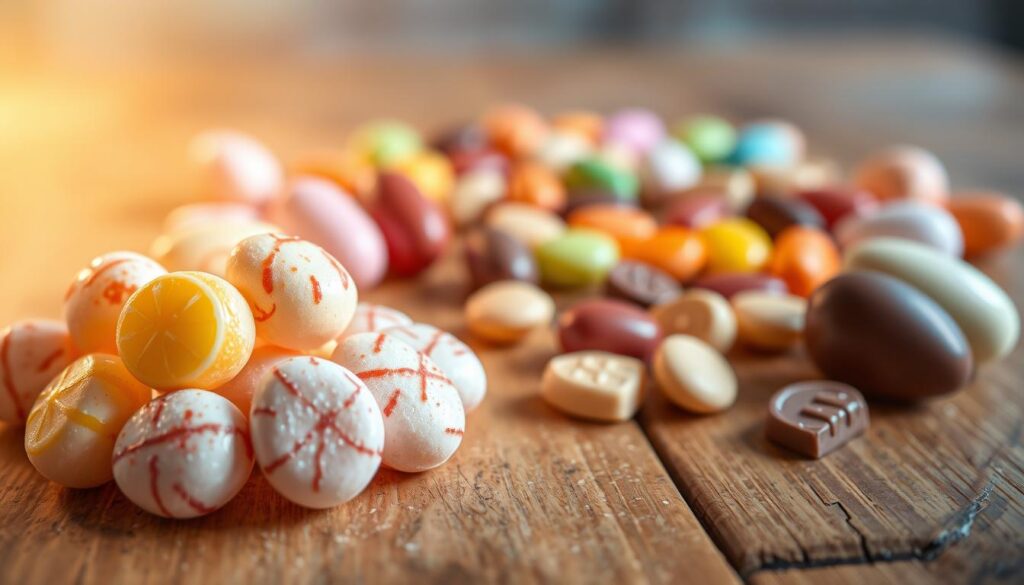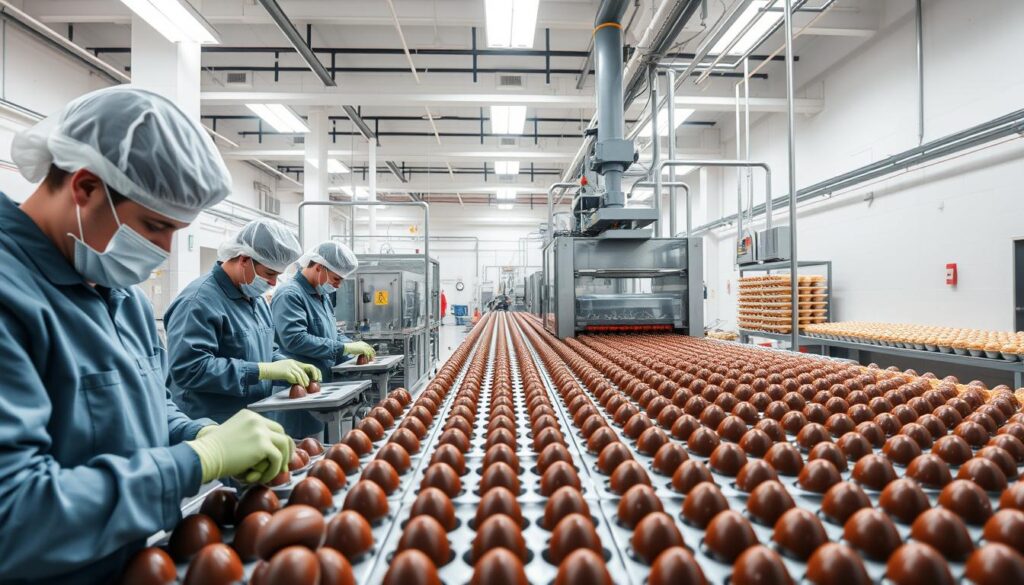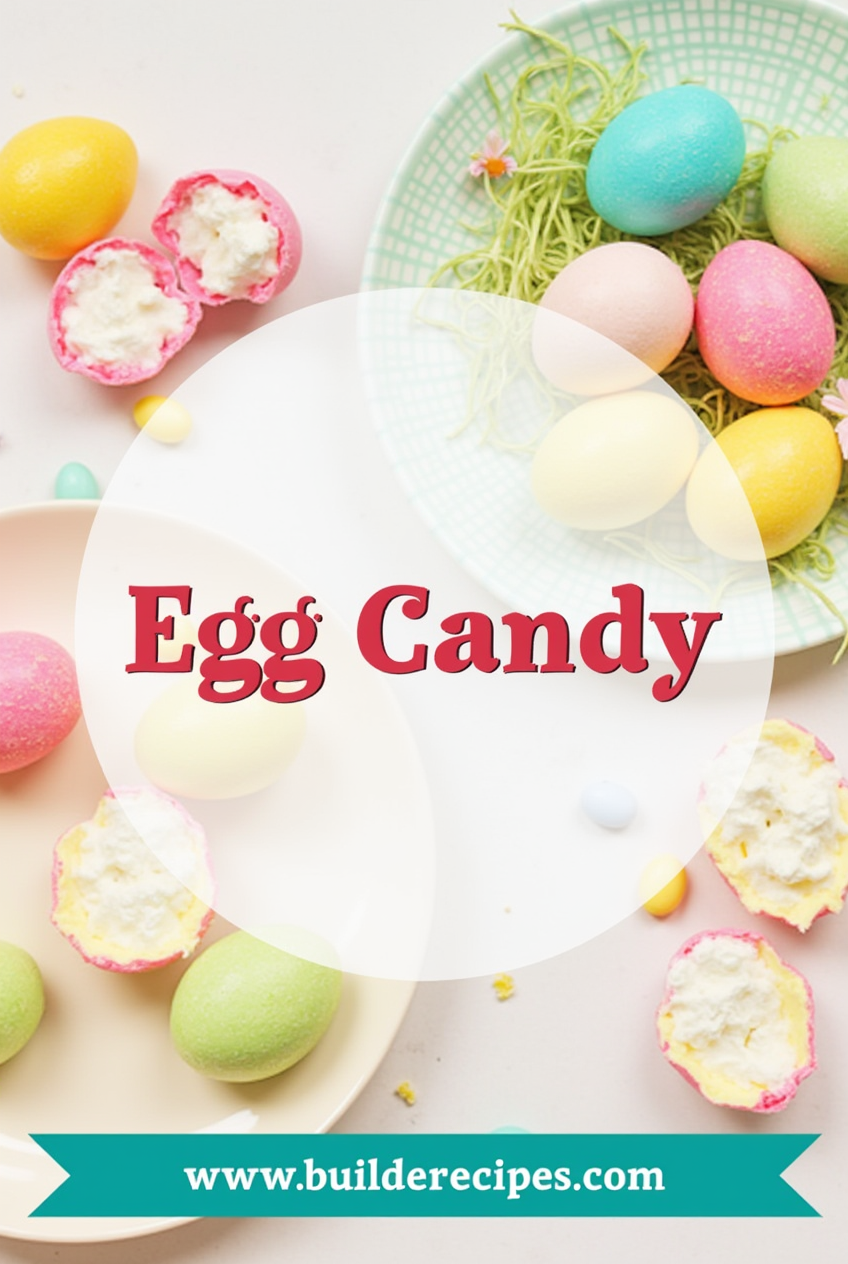Imagine it’s Easter morning, and you find a sweet egg-shaped treat. It takes you right back to your childhood. Egg candy is more than just a sweet treat. It’s a celebration of flavor, creativity, and joy that everyone in the United States loves.
Reese’s Peanut Butter Eggs are a hit in 30 states. Meanwhile, Knipschildt Chocolatier’s hand-painted eggs are a work of art. These treats are not just chocolate. They come in many flavors, designs, and textures that everyone loves.
Do you like classic chocolate eggs or something new like Koko Black’s passionfruit eggs? There’s an egg candy for everyone. These treats are special because of their unique shape, rich flavors, and the happiness they bring during holidays.
Table of Contents
Introduction to Sweet Easter Traditions
Easter is more than a religious holiday. It’s a time filled with candy making and holiday sweets. Over the years, these traditions have grown, turning simple treats into beautiful culinary art.
The history of Easter candy is rich and interesting. In the 19th century, exchanging decorated candies and chocolates became popular. Confectioners then developed new techniques that changed holiday sweets forever.
History of Easter Candy Making
Candy making during Easter has deep roots in culture. Some key moments include:
- In the 1820s, London confectioners created Egg Comfits using gum paste
- The 1920s saw the emergence of hollow chocolate eggs in the United States
- Marshmallow Peeps were introduced in 1953, becoming an instant Easter classic
Cultural Significance of Egg-Shaped Confections
Egg-shaped treats hold deep symbolic meanings. They symbolize rebirth, fertility, and new life. German settlers brought the Easter Bunny to America, linking it with holiday sweets.
Evolution of Easter Treats
The evolution of Easter confections is a story of culinary creativity. From simple sugar eggs to elaborate chocolate creations, candy makers have always pushed the limits. They turn holiday treats into edible art that brings joy to all.
The egg has been a symbol of life and renewal for thousands of years, with traditions dating back to 5000 B.C.
Understanding Egg Candy Varieties
Explore the world of festive treats with chocolate eggs. They come in many flavors, from classic to new ones. Each egg-shaped candy offers a unique sweet experience.
There are many exciting types of chocolate eggs. They make Easter treats special:
- Cream-Filled Chocolate Eggs: Classic treats with smooth, rich centers
- Solid Chocolate Eggs: Pure chocolate in egg form
- Marshmallow Eggs: Soft centers in chocolate
- Jelly Bean-Filled Eggs: Colorful and fun
Regional specialties add unique twists to chocolate eggs. For example, Cincinnati candy makers created Hummingbird Eggs in the 1950s and 1960s. These tiny eggs had hard shells and cream centers in flavors like grape and cherry.
Today, candy makers keep innovating. They make egg-shaped treats that are both gourmet and playful. There’s a chocolate egg for everyone, no matter your taste.
Discover the magic of egg-shaped candies that transform simple sweets into extraordinary festive experiences!
Handcrafted Chocolate Egg Techniques
Making DIY candy at home needs precision and passion. Homemade treats like chocolate eggs require skill. They turn simple ingredients into tasty masterpieces. Your journey to making exquisite chocolate eggs begins with learning the detailed processes used by professionals.
Mastering chocolate egg production involves several key steps. These steps make your homemade treats go from ordinary to extraordinary. Creating these delightful confections needs attention to detail and special techniques.
Tempering Chocolate for Perfect Shells
Chocolate tempering is key for a smooth, glossy finish. The quality of your chocolate shell depends on precise temperature control:
- Heat chocolate to 115°F for dark chocolate
- Cool to 81°F for proper crystallization
- Reheat to 88-90°F for perfect consistency
Filling Selection and Preparation
Choosing the right filling can make your DIY candy go from good to extraordinary. Here are some popular filling options:
| Filling Type | Flavor Profile | Preparation Time |
|---|---|---|
| Caramel | Rich and Sweet | 15 minutes |
| Ganache | Creamy and Intense | 20 minutes |
| Fruit Puree | Light and Tangy | 10 minutes |
Decorative Finishing Methods
Your homemade treats become truly special with creative decorations. Try these techniques:
- Drizzle contrasting chocolate
- Sprinkle edible glitter
- Add hand-painted designs
- Incorporate delicate sugar work
Pro tip: Use high-quality chocolate with 50-70% cocoa content for the best results in your DIY candy projects.
Popular Flavors and Fillings

Egg-shaped candies open up a world of flavors in desserts. Every year, new and tasty fillings are added. These make traditional Easter candies into gourmet treats.
Some top egg candy flavors are:
- Peanut Butter: A favorite like Reese’s Peanut Butter Eggs, which are bigger than usual
- Caramel: Smooth fillings that go well with chocolate shells
- Coconut Cream: A tropical twist on classic sweets
Luxury brands are getting creative with flavors. For example, Vosges has a Magical Flop-Eared Chocolate Bunny. It has deep milk chocolate and pink Himalayan sea salt.
Brands like Lindt and See’s Candies keep making new egg candies. The German Chocolate Egg Truffles, with 24 truffles per box, show off their skill in flavors.
For those who like trying different things, Brach’s Classic Jelly Bird Eggs have many flavors. You can find lime, cherry, grape, raspberry, pineapple, licorice, lemon, and orange. This means there’s something for everyone.
Making Egg Candy at Home
Making your own candy at home is fun and rewarding. You can make chocolate eggs and add your own twist. It’s a great way to enjoy making your own treats.
Before you start, you’ll need some basic tools and ingredients. This will help you make your homemade treats a success.
Essential Tools and Ingredients
- Chocolate molds (egg-shaped)
- High-quality chocolate (12 ounces)
- Confectioners’ sugar (4-6 cups)
- Food coloring (1/4 teaspoon)
- Milk (4 tablespoons)
- Microwave-safe bowl
- Candy thermometer
- Pastry brush
Step-by-Step Process
- Melt chocolate using 50-70% microwave power
- Carefully coat egg molds
- Chill molds for 5-10 minutes
- Prepare filling (2-3 tablespoons per egg half)
- Add decorative toppings
Troubleshooting Common Issues
| Problem | Solution |
|---|---|
| Chocolate seizing | Use oil-based food dye, avoid water contact |
| Thick chocolate coating | Add shortening for smoother consistency |
| Filling breaks during dipping | Refrigerate filling thoroughly before use |
With a little practice, your DIY candy can turn out amazing. Remember to store your homemade treats in an airtight container in the refrigerator for up to 14 days or freeze for two months. Enjoy the joy of making your own chocolate eggs!
Professional Manufacturing Process

Candy making for chocolate eggs uses advanced industrial methods. These methods turn raw ingredients into tasty treats. Professional makers have created detailed processes to make chocolate eggs that people love all over the world.
The making of chocolate eggs starts with picking the best cocoa beans. Most beans come from tropical regions. Countries in South and Central America and West Africa are big producers. The Ivory Coast, the top cocoa producer, is key in getting top-quality chocolate.
- Cocoa bean selection and sourcing
- Precise roasting at 120 degrees Celsius
- Chocolate tempering and molding
- Specialized egg-shaped casting techniques
Big candy making places use high-tech systems to make millions of chocolate eggs every year. Some, like Zitner’s, still make them by hand. This way, each egg gets special care.
“The art of chocolate egg production combines cutting-edge technology with time-honored craftsmanship.” – Chocolate Industry Expert
Keeping the right temperature is key in making chocolate eggs. The Maillard browning reaction and exact cooking temperatures between 240-245 degrees Fahrenheit make them taste so good.
- Automated production lines
- Precision temperature monitoring
- Quality control checkpoints
- Decorative finishing techniques
Today, makers have to be both fast and careful. They face challenges like cocoa shortages and more people wanting special chocolate eggs.
Storage and Shelf Life Tips
Keeping your chocolate eggs and other treats fresh is key. Knowing how to store them right can make them last longer. This way, you can enjoy their taste and texture for months.
Temperature is very important for chocolate eggs. They do best when kept between 60-70°F. Avoiding too much heat or cold is crucial to keep them tasting great.
Proper Temperature Control
- Keep sweet treats away from direct sunlight and heat sources
- Avoid refrigerating chocolate, which can cause condensation
- Maintain a consistent room temperature
Packaging Recommendations
It’s vital to keep chocolate eggs from air and moisture. This helps keep their flavor and texture just right.
| Candy Type | Recommended Storage | Approximate Shelf Life |
|---|---|---|
| Dark Chocolate Eggs | Airtight container | Up to 2 years |
| Milk Chocolate Eggs | Cool, dry place | Up to 10 months |
| Soft Filled Chocolate Eggs | Sealed bag or container | 6-9 months |
Preservation Methods
Pro tip: Store your treats in a cool, dry spot like a pantry or cupboard. Places with high humidity, like basements or garages, can make them spoil faster.
“The key to preserving chocolate is creating a stable environment that protects it from temperature fluctuations and moisture.” – Chocolate Preservation Expert
By sticking to these storage tips, your chocolate eggs and other treats will stay fresh and tasty. They’ll be ready to enjoy for a longer time.
Conclusion
Egg candy is a hit across the United States, especially during holidays. It’s not just about Reese’s Peanut Butter Eggs or chocolate designs. These treats are a big part of our celebrations.
Looking into egg candy shows a world of creativity and tradition. Companies like Hershey’s and Mondelez saw big profits in 2023. This shows how much people love these festive treats.
Whether you like homemade or store-bought egg candy, there’s something for everyone. The rise of treats like Kinder Joy shows the fun in this field. As chocolate prices change and new recipes come out, egg candy keeps bringing joy to all.
Try new flavors, learn new techniques, or make your own treats. The world of festive confections is full of sweet surprises. It’s waiting for you to explore.
FAQs:
What egg-shaped candy was illegal in the United States?
- Kinder Surprise (also known as Kinder Eggs) was banned in the U.S. due to regulations prohibiting non-edible items inside food products. However, Kinder Joy, which separates the toy from the chocolate, is legal.
What is egg candy?
- “Egg candy” refers to various sweets shaped like eggs, typically associated with Easter. Examples include chocolate eggs, marshmallow eggs, and candy-coated eggs (like Cadbury Mini Eggs or Robin Eggs).
Is Brach’s Easter Egg Hunt candy discontinued?
- Yes, Brach’s Easter Egg Hunt candy appears to be discontinued, as it’s no longer widely available in stores or online. However, Brach’s still makes other Easter-themed candies.
What flavor is the egg candy?
- The flavor varies by brand and type. Common flavors include milk chocolate, white chocolate, fruit flavors (for jelly eggs), malted milk (like Robin Eggs), and marshmallow (like Peeps Eggs).

